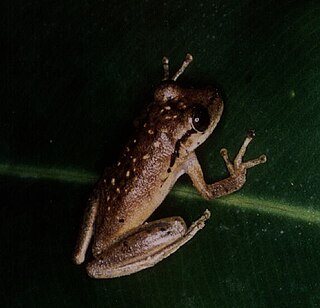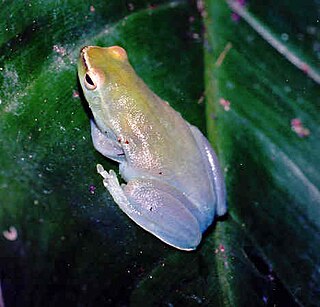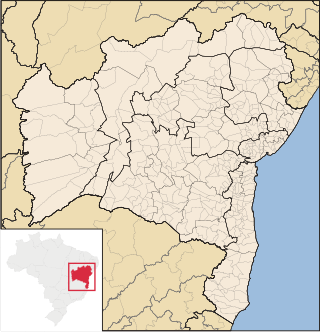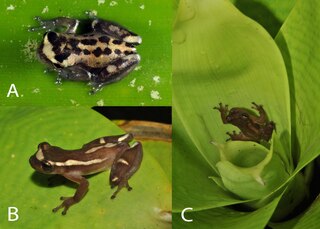
Scinax is a genus of frogs, commonly known as snouted treefrogs, in the family Hylidae. The genus is found from eastern and southern Mexico to Argentina and Uruguay, and in Trinidad and Tobago, and Saint Lucia. Member species are small to moderate-sized tree frogs, drably colored. Duellman and Wiens resurrected this genus in 1992. The name originates from the Greek word skinos, meaning quick or nimble.

Sphaenorhynchus is a genus of frogs in the family Hylidae. They are also known as lime treefrogs or hatchet-faced treefrogs. They are found in the Amazon and Orinoco River basins of South America, the Guianas, Trinidad, and southern and eastern Brazil. The majority of the species are associated with the Atlantic Forest domain in Brazil.

Nyctimantis is a genus of frogs in the family Hylidae. The genus is found in south-eastern Brazil as well as in the Orinoco Basin in Venezuela, Colombia, and Brazil. These are tree-dwelling species usually hiding in the cisterns of epiphytic bromeliads. The top of the head carries a bony plate which is fused with the skin.
Dendropsophus berthalutzae is a species of frog in the family Hylidae. It is endemic to southeastern Brazil and occurs in the coastal lowlands and the Serra do Mar in Espírito Santo, Minas Gerais, Rio de Janeiro, São Paulo, and eastern Paraná states. It is named in honor of Bertha Lutz, a Brazilian zoologist and feminist. Common name Bertha's treefrog has been coined for it.
Sphaenorhynchus platycephalus, commonly known as the South American lime treefrog or Lutz's lime treefrog, is a species of frog in the family Hylidae. It is endemic to south-eastern Brazil where it occurs in the Serra do Mar and Serra da Mantiqueira ranges in the states of Rio de Janeiro, São Paulo, and Minas Gerais. However, Araujo-Vieira and colleagues suggests that the Serra da Mantiqueira population could represent Sphaenorhynchus canga; the two species are similar.

Nyctimantis arapapa, also known as Bahia's broad-snout casque-headed tree frog, is a species of frog endemic to the Atlantic Rainforest of southern Bahia, Brazil. The frogs of the genus Nyctimantis are distinguished by a bony plate on top of their heads, referred to as "casque-headed". Casque-headed frogs are characterized by their phragmotic behavior. N. arapapa is further characterized by the long bill-shaped "snout" they possess, similar to that of Triprion petasatus, a head longer than it is wide, and their small size. This species, and all species of Nyctimantis, use their unique head shape to seal off the leaves of bromeliads, the plant they inhabit solely. This has two known purposes: warding off predators from the frog as well as their young, and trapping moisture.

Adenomera saci is a species of frog in the family Leptodactylidae. It is endemic to central-western and northern Brazil. Prior to its description by Carvalho and Giaretta in 2013, it was confused with Adenomera martinezi. The specific name saci is Portuguese word for a kind of whistling imp in Brazilian (Tupi) folklore, in allusion to the whistling call of this frog.
Nyctimantis galeata is a species of frog in the family Hylidae. It is endemic to Brazil and only known from its type locality near Morro do Chapéu, Bahia, in the northern part of the Espinhaço Mountains. The specific name galeata is derived from Latin and means "covered with a helmet", in reference to the co-ossified head of this frog.
Osteocephalus sangay, also known as the Sangay casqued tree frog, is a species of frog in the family Hylidae. It is found in eastern Ecuador in Morona Santiago province. O. sangay is in the O. buckleyi species group and is closely related to O. cannatellai.
Phasmahyla cruzi is a species of frog in the subfamily Phyllomedusinae. It is endemic to Brazil and solely known from the vicinity of its type locality, Rio das Pedras Reserve in the municipality of Mangaratiba, Rio de Janeiro state. The range extends into the adjacent Paraty municipality. This species is named for Carlos Alberto Gonçalves da Cruz, Brazilian herpetologist. The common name Mangaratiba tree frog has been proposed for it.

Scinax tropicalia, or Tropicalia's snouted treefrog, is a frog. Scientists report two distinct populations, both in Atlantic forest in Brazil. It lives no more than 600 meters above sea level.
Scinax rupestris, the Veadeiros snouted tree frog, is a species of frog in the family Hylidae. It is endemic to Brazil and has been found in the state of Goiás.
Scinax cabralensis is a frog in the family Hylidae. It is endemic to Brazil. Scientists observed some of these frogs 1070 meters above sea level.
Scinax rossaferesae is a frog in the family Hylidae. It is endemic to Brazil and has been observed in the Guartelá Canyon area.

Dendropsophus counani is a frog in the family Hylidae. It is endemic to Brazil, French Guiana, Suriname, and Guyana.
Sphaenorhynchus botocudo is a frog in the family Hylidae endemic to Brazil.
Sphaenorhynchus canga is a frog in the family Hylidae. It is endemic to Minas Gerais, Brazil.
Dendropsophus reichlei is a frog in the family Hylidae endemic to Bolivia, Peru, and Brazil.

Dendropsophus bromeliaceus, or Teresensis' bromeliad frog, is a frog in the family Hylidae, endemic to Brazil. Scientists have only seen it in the mountains in the Reserva Biológica Augusto Ruschi.\
Scinax cosenzai is a species of frog in the family Hylidae. It is endemic to Brazil. People have seen it in the Parque Estadual da Serra do Brigadero in Minas Gerais.







